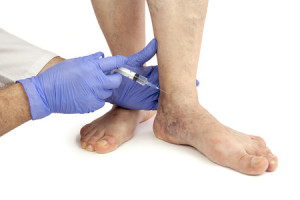
What are varicose veins?
Veins are vessels which are designed to carry de-oxygenated blood back to the heart from the tissues of the body. Varicose veins, however, are abnormally dilated veins that cannot perform their function.
Varicose veins are larger veins that bulge above the skin surface which are commonly found in association with larger and deeper vein problems. If there is a deeper vein problem can be detected at an initial examination.
Dilated blood vessels often cause aching especially after prolonged standing. Although dilated blood vessels do carry blood they are not very efficient and are often not necessary to the circulatory system. The body has an already established alternative route for the blood to travel back more efficiently to the heart (deep venous system). Thus they can be treated without damaging the circulation. In fact, treatment actually improves venous circulation. The probability of a greatly improved appearance following treatment is about 80 per cent depending on the severity of the problem. Treatment will also usually relieve any symptoms caused by the veins.
What causes varicose veins?
Since our ancestors decided to stand upright, our leg veins have been faced with the difficult task of taking the blood up to the heart against the pulling force of gravity. To do this the leg veins depend on the contraction of the calf and thigh muscles to pump the blood. This is why walking is good for your circulation.
So when you walk, the contraction of your leg muscles pumps the blood up. However, as the saying goes “what goes up must come down” which is what happens to blood in the leg veins. Therefore, to prevent the blood from falling back down, nature has designed valves in the leg veins which open in only one direction: upwards. So the valves allow the blood to get through but when it comes back down, the valves shut and stop the blood going all the way down. The next contraction sends the blood even higher until it eventually reaches the heart.
In venous disease, the underlying problem appears to be damage to the valves. The abnormal reticular veins, for instance, act as “feeders” of the spider veins. The blood flow in these feeder veins can compared to a “two-way” street. In other words, blood in the feeder veins can go back and forth. This backward flow through the incompetent valves dilates up the smaller veins (medically called “post-capillary venules”). These dilated post-capillary venules are commonly referred to as “spider veins”.
The same principle applies to varicose veins. The abnormal valve cannot stop the blood from rushing back down. The blood in these veins is oxygen low and in fact carries a lot of toxins. In the case of varicose veins, this “toxic” blood pools in the legs and cannot be returned to the circulation. This is why patients with varicose veins suffer from night cramps and their legs feel heavy at the end of the day.
Varicose veins occur in both men and women. A definitive cause is not known, however a strong family history suggests that some people inherit veins that are more likely to deteriorate. In women, oestrogen may play a role as the onset of puberty, pregnancy and taking oral contraceptives can give rise to vein abnormalities. In pregnancy, the enlarged uterus can restrict blood flow from the legs and promote the development of varicose veins. Spider veins and varicose veins are also associated with obesity. Occupations involving prolonged standing tend to increase the likelihood of veins to develop. Bone fractures and soft tissue trauma can cause localized vein abnormalities.
Can we do without varicose veins? Where does the blood go?
Varicose veins serve no useful function to the body’s circulation. They do not return blood to the heart and our body has already established alternative pathways to bypass the abnormal varicose veins. When varicose veins are closed down, the circulatory system improves, as do many of the symptoms. It is important to understand that varicose veins can be a progressive condition and that new veins can develop with time. Ongoing maintenance treatment is likely for most patients.
Can vein problems be prevented?
There is no known method of prevention. Wearing specialised venous support stockings may prevent some dilated blood vessels from developing in some people. Maintaining a normal weight, regular exercise, avoiding constipation and avoiding wearing high heeled shoes may also be helpful.
